Livestock Monitoring Market Size
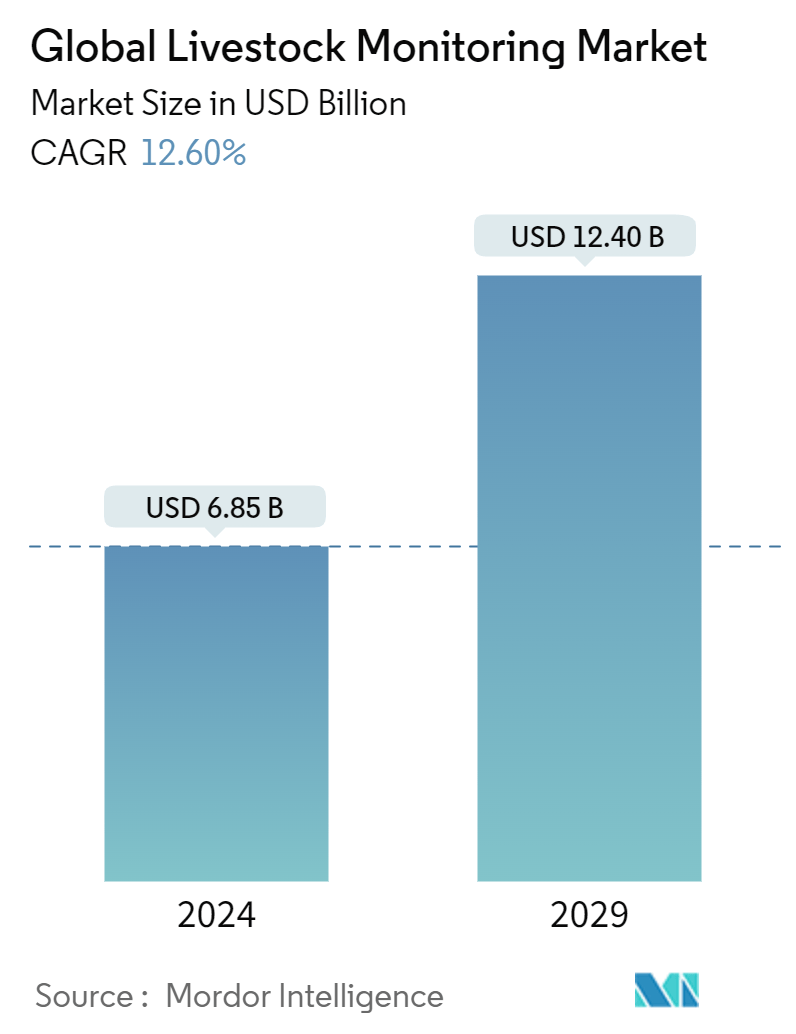
| Study Period | 2019 - 2029 |
| Market Size (2024) | USD 6.85 Billion |
| Market Size (2029) | USD 12.40 Billion |
| CAGR (2024 - 2029) | 12.60 % |
| Fastest Growing Market | Asia-Pacific |
| Largest Market | North America |
| Market Concentration | Medium |
Major Players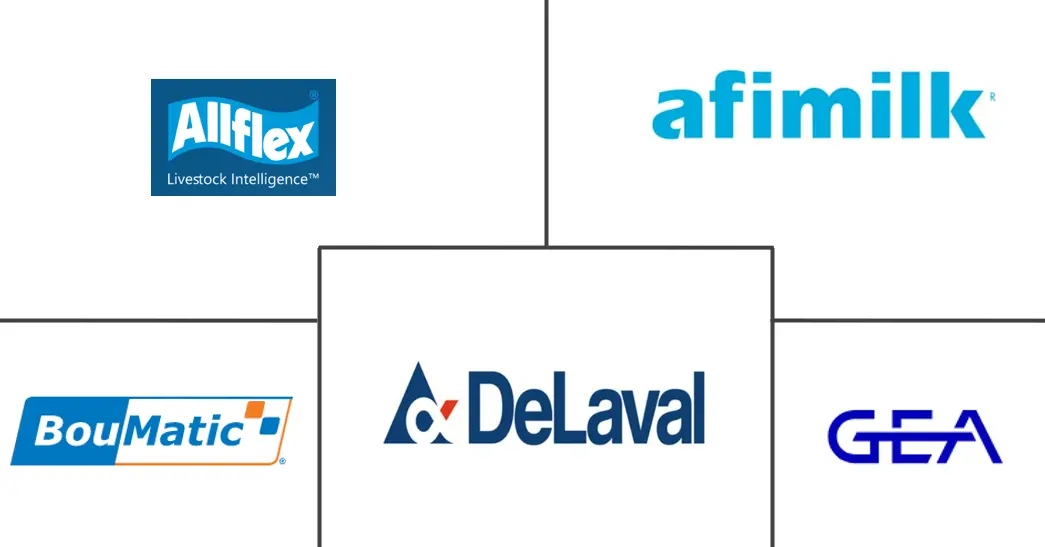
*Disclaimer: Major Players sorted in no particular order |
Livestock Monitoring Market Analysis
The Global Livestock Monitoring Market size is estimated at USD 6.85 billion in 2024, and is expected to reach USD 12.40 billion by 2029, at a CAGR of 12.60% during the forecast period (2024-2029).
The market's growth is driven by several factors such as expanding cow population, rising incidences of zoonotic diseases, and increased adoption of livestock monitoring technologies due to associated cost savings. The global livestock population has shown steady growth in recent decades. As of 2023, India, Brazil, and China collectively represented over 64% of the global cattle inventory. Managing such large numbers requires real-time monitoring solutions to ensure optimal health and productivity. In developed countries, animal monitoring devices have become increasingly common, enabling continuous livestock observation. Key drivers of market growth include a focus on real-time monitoring and early disease detection, increased integration of IoT and AI in livestock monitoring, and rising global meat demand. For instance, in April 2023, Advantech Co. Ltd. introduced an AI-powered system for early detection of livestock health issues. This system combines artificial intelligence and infrared vision to measure individual cow body temperatures.
The livestock management industry is experiencing significant transformation due to intense competition among market participants. Companies are focusing on expanding product lines and driving innovations to gain a competitive edge. A key trend is the integration of software platforms with hardware solutions, enabling improved data management, enhanced decision-making processes, and reduced labor costs. Government support initiatives aimed at enhancing livestock monitoring are further propelling market growth. For instance, the development of ClearFarm by the Universitat Autònoma de Barcelona (UAB) in February 2024, was funded by the European Union. This platform utilizes sensors installed on farms and animals to monitor various factors, including animal behavior, physical and mental health, environmental impact, and productivity.
North America and Europe dominate the livestock monitoring market, primarily due to their large-scale commercial livestock operations and advanced technological infrastructure. Strict animal welfare regulations and environmental sustainability requirements in these regions further strengthen their market position. The Asia-Pacific region is projected to experience rapid growth in this market, driven by rising demand for meat and dairy products, expanding livestock populations, and a gradual shift towards commercial farming practices. The global livestock monitoring market continues to evolve as technology transforms modern livestock farming methods.
Livestock Monitoring Market Trends
Poultry Segment Expects to Drive the Market Growth
- The global livestock monitoring market is experiencing significant growth, driven in part by the expansion of the poultry segment. Poultry farming is one of the fastest-growing segments within the livestock industry, propelled by increasing global demand for meat and eggs. The rise in daily consumption of poultry products is a key factor behind this segment's growth. The Organization for Economic Cooperation and Development-Food and Agriculture Organization (OECD-FAO) Agricultural Outlook report projects that global consumption of meat proteins will increase by 17.8% by 2030 compared to the 2018-2020 base period average.
- Meat consumption patterns are shifting towards poultry. In developing countries with lower incomes, this trend reflects the lower cost of poultry compared to other meats. In high-income countries, the shift indicates a growing preference for white meats, which are easier to prepare and often perceived as healthier. This consumption trend is driving commercial farming, with leading producers such as the United States, China, and Brazil accounting for a substantial portion. The United States Census Bureau projects that the United States population will grow from 319 million in 2014 to 417 million in 2060. This population growth, along with the rising poultry population, has intensified the need for efficient livestock management systems, particularly in leading poultry-producing regions.
- Poultry farmers are increasingly utilizing sensors, wearable devices, and automation technologies to gather real-time data on crucial factors such as temperature, humidity, feed consumption, and bird activity. This information is essential for maintaining optimal conditions in poultry houses, reducing disease outbreaks, and enhancing overall production efficiency. In June 2024, the USDA launched a monitoring and surveillance program to track the spread of avian influenza in the United States, addressing a major concern in the livestock population. This program enables farmers and producers to detect and treat the disease promptly.
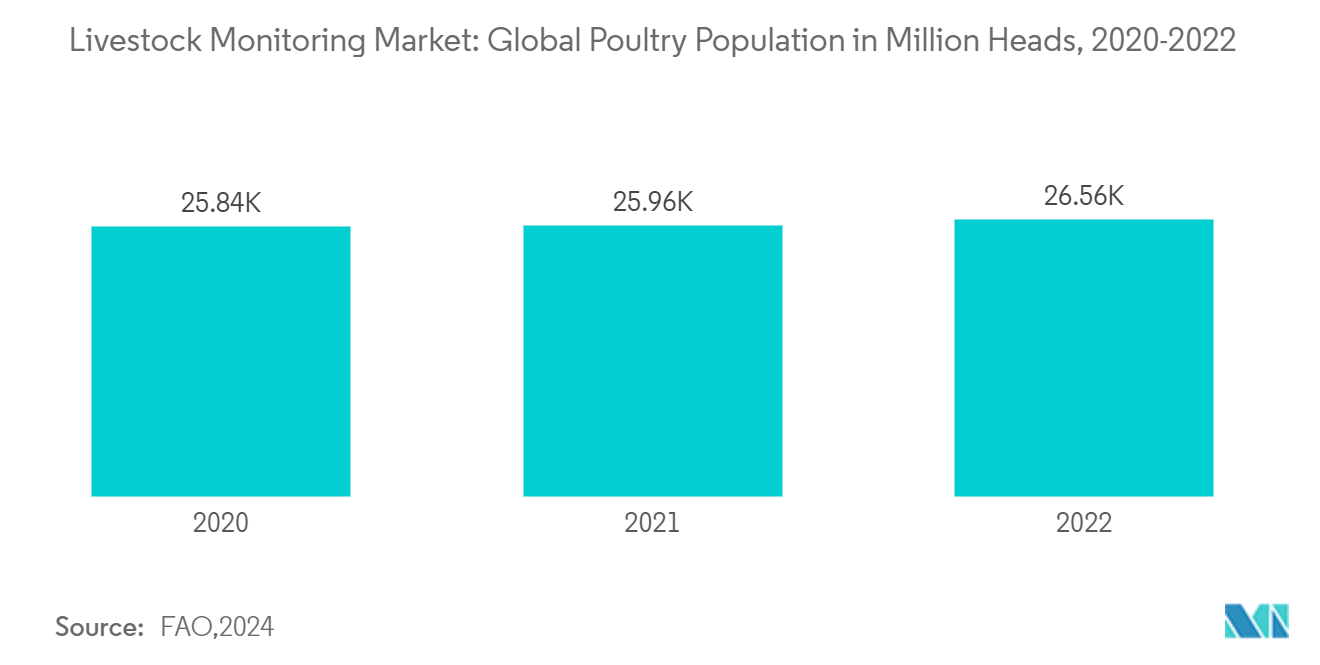
North America is Expected to Have a Significant Market Share
- The North American market dominates the global livestock monitoring sector, primarily due to the increasing need for technology to monitor animal health, especially in light of zoonotic disease concerns. The United States and Canada have large and diverse livestock industries, including cattle, poultry, swine, and dairy. As of 2023, the United States had over 94 million cattle, while Canada had approximately 12 million. This substantial livestock population necessitates efficient management solutions.
- Monitoring technologies such as RFID, wearable sensors, and automated data collection systems have become crucial for maintaining herd health, tracking movement, and optimizing feeding practices. According to National Beef Wire data from June 2024, the United States accounted for 18.0% of global bovine meat production in 2023, making it the top producer. Monitoring systems help reduce disease-related losses and ensure animals reach optimal slaughter weight, improving operational efficiency in large-scale farms and driving demand for these technologies.
- Governments, companies, and industry professionals in North America are accelerating the development and implementation of advanced livestock monitoring systems. The United States Department of Agriculture (USDA) has introduced initiatives such as the monitoring and surveillance program, while the Canadian government supports smart farming technologies through its Canadian Agricultural Partnership (CAP). These efforts significantly contribute to the advancement of the livestock monitoring market. Private companies such as BouMatic, Allflex (Merck), and Fancom BV are introducing artificial intelligence-based solutions to monitor and automate farm activities. Additionally, companies are providing cattle care training to caretakers. For instance, Merck Animal Health's Cattle Care365 program offers training for beef cattle caretakers to maintain livestock safety, productivity, and health.
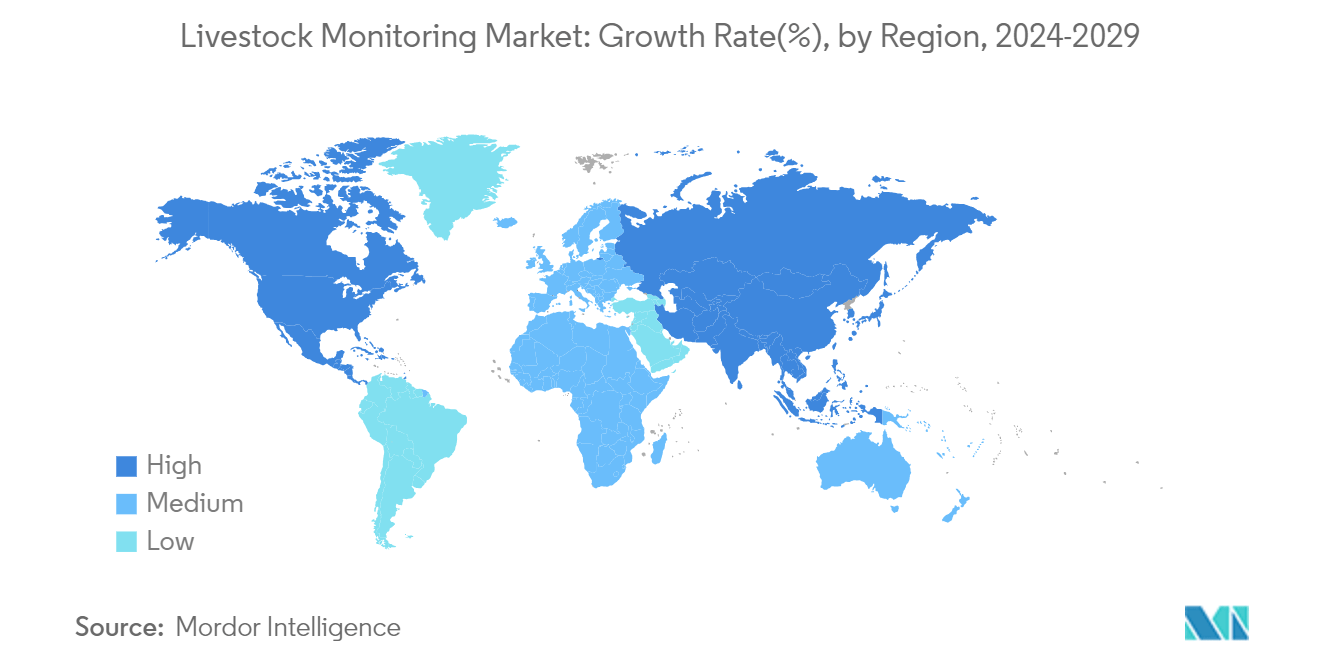
Livestock Monitoring Industry Overview
The global livestock monitoring market is consolidated with the presence of many players. As a result, players focus on developing advanced monitoring systems and sensors, cost reduction, and innovation to ensure sustainability. Some of the major players are Merck & Co., Inc. (Allflex), Afimilk Ltd., DeLaval, GEA Farm Technologies, and BouMatic.
Livestock Monitoring Market Leaders
-
GEA Farm Technologies
-
Afimilk Ltd.
-
DeLaval
-
BouMatic
-
Merck & Co., Inc. (Allflex)
*Disclaimer: Major Players sorted in no particular order
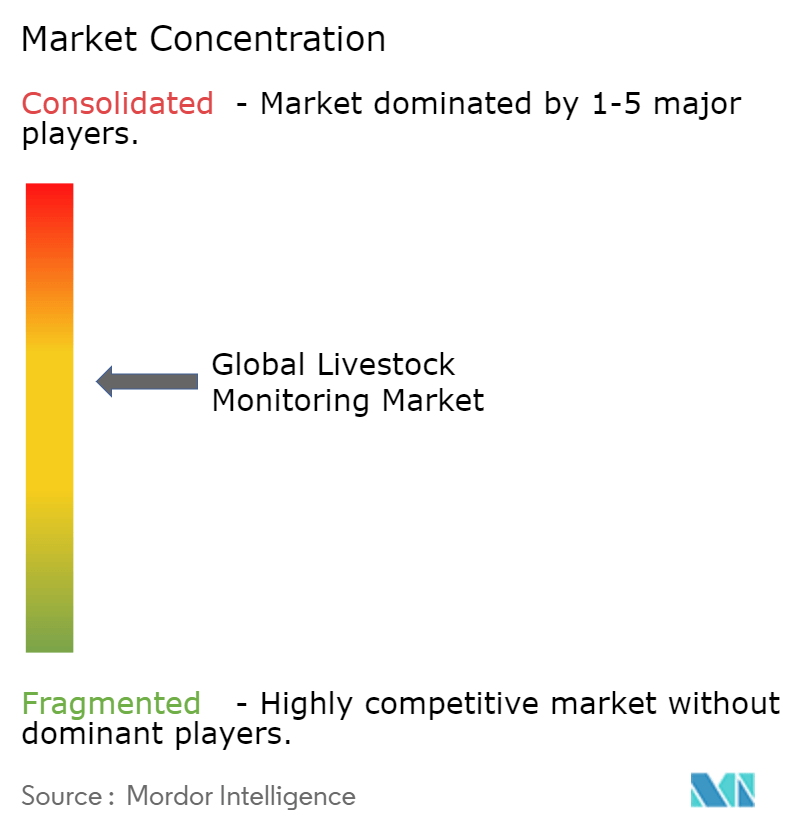
Livestock Monitoring Market News
- April 2024: BouMatic formed a partnership with Brolis Sensor Technology to integrate Brolis' in-line milk analyzer into the Gemini UP milking robot and other BouMatic milking systems. This collaboration aims to provide farmers with comprehensive solutions that enhance milk yields, reduce operational costs, and improve animal welfare.
- April 2024: Merck introduced SENSEHUB Dairy Youngstock, an innovative activity monitoring system designed for dairy calves from birth to 12 months of age. This technology assists dairy producers and calf managers in efficiently identifying and locating calves and heifers requiring attention.
- March 2024: GEA acquired CattleEye, an agricultural technology company that utilizes artificial intelligence to enhance herd management practices. The system employs a 2D camera and specialized software to analyze cow movement and body data, assisting farmers in assessing their herd's health.
Livestock Monitoring Market Report - Table of Contents
1. INTRODUCTION
1.1 Study Assumptions and Market Definition
1.2 Scope of the Study
2. RESEARCH METHODOLOGY
3. EXECUTIVE SUMMARY
4. MARKET DYNAMICS
4.1 Market Overview
4.2 Market Drivers
4.2.1 Increasing Prevalence of Major Animal Diseases
4.2.2 Emphasis on Real-time Monitoring and Early Disease Detection
4.2.3 Regulatory Push for Livestock Health and Traceability Standards
4.3 Market Restraints
4.3.1 High Cost of Livestock Monitoring Solutions
4.3.2 Lack of Understanding of Technology Among Farmers
4.4 Porter's Five Forces Analysis
4.4.1 Threat of New Entrants
4.4.2 Bargaining Power of Buyers/Consumers
4.4.3 Bargaining Power of Suppliers
4.4.4 Threat of Substitute Products
4.4.5 Intensity of Competitive Rivalry
5. MARKET SEGMENTATION
5.1 Livestock Type
5.1.1 Cattle
5.1.2 Poultry
5.1.3 Swine
5.1.4 Others
5.2 Component
5.2.1 Devices
5.2.2 Services and Software
5.3 Application
5.3.1 Milk Harvesting
5.3.2 Breeding Management
5.3.3 Feeding Managemnet
5.3.4 Others
5.4 Geography
5.4.1 North America
5.4.1.1 United States
5.4.1.2 Canada
5.4.1.3 Mexico
5.4.2 Europe
5.4.2.1 Germany
5.4.2.2 United Kingdom
5.4.2.3 France
5.4.2.4 Italy
5.4.2.5 Spain
5.4.2.6 Rest of Europe
5.4.3 Asia-Pacific
5.4.3.1 China
5.4.3.2 Japan
5.4.3.3 India
5.4.3.4 Australia
5.4.3.5 South Korea
5.4.3.6 Rest of Asia-Pacific
5.4.4 Middle-East and Africa
5.4.4.1 GCC
5.4.4.2 South Africa
5.4.4.3 Rest of Middle-East and Africa
5.4.5 South America
5.4.5.1 Brazil
5.4.5.2 Argentina
5.4.5.3 Rest of South America
6. COMPETITIVE LANDSCAPE
6.1 Company Profiles
6.1.1 Merck & Co., Inc. (Allflex)
6.1.2 Lely International NV
6.1.3 GEA Farm Technologies
6.1.4 Afimilk Ltd.
6.1.5 DeLaval
6.1.6 Dairymaster Ltd.
6.1.7 BouMatic
6.1.8 Moocall
6.1.9 HID Global Corporation
6.1.10 Fancom BV (CTB, Inc.)
7. MARKET OPPORTUNITIES AND FUTURE TRENDS
Livestock Monitoring Industry Segmentation
Livestock monitoring technology involves collecting data to alert farmers about the conditions of their livestock environment. This technology tracks animals' nutrition, reproduction, and overall well-being in real-time, enabling farmers to observe and manage their livestock effectively. The global livestock monitoring market is segmented by animal type (Cattle, Poultry, Equine, and Others), component (Hardware, Software, and Services), application (Feeding Management, Milk Harvesting, Breeding Management, and Others), and geography (North America, Europe, Asia-Pacific, Middle-East and Africa, and South America). The report offers the market size in value terms (USD) for the above segments.
| Livestock Type | |
| Cattle | |
| Poultry | |
| Swine | |
| Others |
| Component | |
| Devices | |
| Services and Software |
| Application | |
| Milk Harvesting | |
| Breeding Management | |
| Feeding Managemnet | |
| Others |
| Geography | ||||||||
| ||||||||
| ||||||||
| ||||||||
| ||||||||
|
Livestock Monitoring Market Research FAQs
How big is the Global Livestock Monitoring Market?
The Global Livestock Monitoring Market size is expected to reach USD 6.85 billion in 2024 and grow at a CAGR of 12.60% to reach USD 12.40 billion by 2029.
What is the current Global Livestock Monitoring Market size?
In 2024, the Global Livestock Monitoring Market size is expected to reach USD 6.85 billion.
Who are the key players in Global Livestock Monitoring Market?
GEA Farm Technologies, Afimilk Ltd., DeLaval, BouMatic and Merck & Co., Inc. (Allflex) are the major companies operating in the Global Livestock Monitoring Market.
Which is the fastest growing region in Global Livestock Monitoring Market?
Asia-Pacific is estimated to grow at the highest CAGR over the forecast period (2024-2029).
Which region has the biggest share in Global Livestock Monitoring Market?
In 2024, the North America accounts for the largest market share in Global Livestock Monitoring Market.
What years does this Global Livestock Monitoring Market cover, and what was the market size in 2023?
In 2023, the Global Livestock Monitoring Market size was estimated at USD 5.99 billion. The report covers the Global Livestock Monitoring Market historical market size for years: 2019, 2020, 2021, 2022 and 2023. The report also forecasts the Global Livestock Monitoring Market size for years: 2024, 2025, 2026, 2027, 2028 and 2029.
Livestock Monitoring Industry Report
Statistics for the 2024 Livestock Monitoring market share, size and revenue growth rate, created by ����vlog��ý™ Industry Reports. Livestock Monitoring analysis includes a market forecast outlook to 2029 and historical overview. Get a sample of this industry analysis as a free report PDF download.



